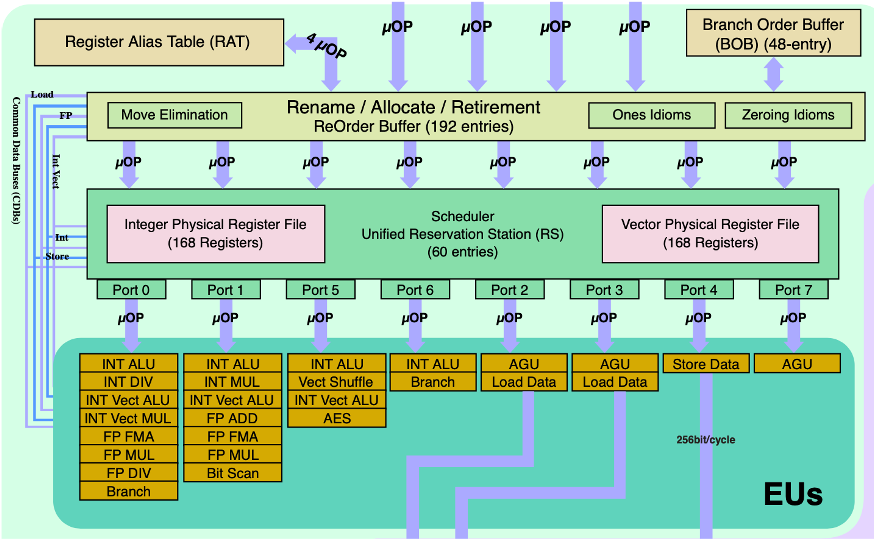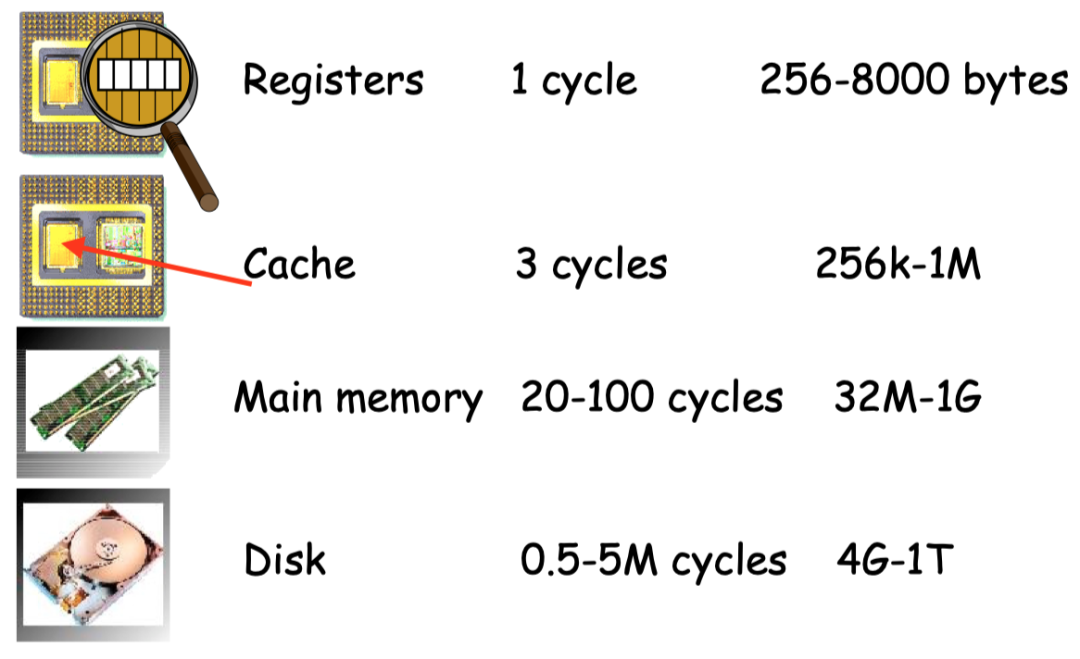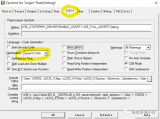線性掃描
接下來介紹一種不同思路的算法:線性掃描。算法描述如下[4]:
LinearScanRegisterAllocation:
active := {}
for i in live interval in order of increasing start point
ExpireOldIntervals(i)
if length(avtive) == R
SpillAtInterval(i)
else
register[i] := a regsiter removed from pool of free registers
add i to active, sorted by increasing end point
ExpireOldInterval(i)
for interval j in active, in order of increaing end point
if endpoint[j] >= startpoint[i]
return
remove j from active
add register[j] to pool of free registers
SpillAtInterval(i)
spill := last interval in active
if endpoint[spill] > endpoint[i]
register[i] := register[spill]
location[spill] := new stack location
remove spill from active
add i to active, sorted by increasing end point
else
location[i] := new stack location
live interval其實就是變量的生命期,用活躍變量分析可以算出來。不過需要標(biāo)識第一次出現(xiàn)和最后一次出現(xiàn)的時間點。
舉個例子:

圖10
| 變量名 | live interval |
|---|---|
| a | 1,2 |
| d | 2,3,4,5 |
| e | 3,4,5,6 |
llvm中實現(xiàn)
在上文中介紹的算法都是作用在最普通的四元式上,但LLVM-IR是SSA形式,有PHI節(jié)點,但PHI節(jié)點沒有機(jī)器指令表示,所以在寄存器分配前需要把PHI節(jié)點干掉,消除PHI節(jié)點的算法限于篇幅不展開,如感興趣的話請后臺留言。
llvm作為工業(yè)級編譯器,有多種分配算法,可以通過llc的命令行選項-regalloc=pbqp|greedy|basic|fast來手動控制分配算法。
不同優(yōu)化等級默認(rèn)使用算法也不同:O2和O3默認(rèn)使用greedy,其他默認(rèn)使用fast。
fast算法的策略很簡單,掃描代碼并為出現(xiàn)的變量分配寄存器,寄存器不夠用就溢出到內(nèi)存。用途主要是 調(diào)試 。
basic算法以linearscan為基礎(chǔ)并對life interval設(shè)置了溢出權(quán)重而且用優(yōu)先隊列來存儲life interval。
greedy算法也使用優(yōu)先隊列,但特點是先為生命期長的變量分配寄存器,而短生命期的變量可以放在間隙中,詳情可以參考[5]。
pbqp算法全稱是Partitioned Boolean Quadratic Programming,限于篇幅,感興趣的讀者請查閱[6]。
至于具體實現(xiàn),自頂向下依次是:
TargetPassConfig::addMachinePasses含有寄存器分配和其他優(yōu)化addOptimizedRegAlloc中是與寄存器分配密切相關(guān)的pass,比如上文提到的消除PHI節(jié)點addRegAssignAndRewriteOptimized是實際的寄存器分配算法- 寄存器分配相關(guān)文件在lib/CodeGen下的RegAllocBase.cpp、RegAllocGreedy.cpp、RegAllocFast.cpp、RegAllocBasic.cpp和RegAllocPBQP.cpp等。
- RegAllocBase類定義了一系列接口,重點是selectOrSplit和enqueue/dequeue方法,數(shù)據(jù)結(jié)構(gòu)的重點是priority queue。selectOrSplit方法可以類比上文中提到的SpillAtInterval。priority queue類比active list。簡要代碼如下:
void RegAllocBase::allocatePhysRegs() {
// 1. virtual reg其實就是變量
while (LiveInterval *VirtReg = dequeue()) {
// 2.selectOrSplit 會返回一個可用的物理寄存器然后返回新的live intervals列表
using VirtRegVec = SmallVector4>;
VirtRegVec SplitVRegs;
MCRegister AvailablePhysReg = selectOrSplit(*VirtReg, SplitVRegs);
// 3.分配失敗檢查
if (AvailablePhysReg == ~0u) {
...
}
// 4.正式分配
if (AvailablePhysReg)
Matrix->assign(*VirtReg, AvailablePhysReg);
for (Register Reg : SplitVRegs) {
// 5.入隊分割后的liver interval
LiveInterval *SplitVirtReg = &LIS->getInterval(Reg);
enqueue(SplitVirtReg);
}
}
}
至于這四種算法的性能對比,我們主要考慮三個指標(biāo):運行時間、編譯時間和溢出次數(shù)。

圖11 各算法的運行時間,圖源[6]
橫坐標(biāo)是測試集,縱坐標(biāo)是以秒為單位的運行時間

圖12 各算法的編譯時間,圖源[6]
橫坐標(biāo)是測試集,縱坐標(biāo)是編譯時間

圖13 各算法的溢出次數(shù),圖源[6]
從這三幅圖可以看出greedy算法在大多數(shù)測試集上都優(yōu)于其他算法,因此greedy作為默認(rèn)分配器是可行的。
小結(jié)
我們通過一個例子介紹了活躍變量分析和圖著色算法。借助活躍變量分析,我們知道了變量的生命期,有了變量生命期建立干涉圖,對干涉圖進(jìn)行著色。如果著色失敗,可以選擇某個變量溢出到內(nèi)存中。之后在RIG的基礎(chǔ)上介紹了寄存器合并這一變換。
然后我們簡單介紹了不同思路的寄存器分配算法:linearscan。最后介紹了llvm12中算法的實現(xiàn)并對比了llvm中四種算法的性能差異。
參考
- http://www.cs.cmu.edu/afs/cs.cmu.edu/academic/class/15745-s18/www/lectures/L5-Intro-to-Dataflow-pre-class.pdf
- http://web.cecs.pdx.edu/~mperkows/temp/register-allocation.pdf
- http://www.cs.cmu.edu/afs/cs.cmu.edu/academic/class/15745-s18/www/lectures/L12-Register-Allocation.pdf http://www.cs.cmu.edu/afs/cs.cmu.edu/academic/class/15745-s18/www/lectures/L13-Register-Coalescing.pdf
- http://web.cs.ucla.edu/~palsberg/course/cs132/linearscan.pdf
- http://blog.llvm.org/2011/09/greedy-register-allocation-in-llvm-30.html
- T. C. d. S. Xavier, G. S. Oliveira, E. D. d. Lima and A. F. d. Silva, "A Detailed Analysis of the LLVM's Register Allocators," 2012 31st International Conference of the Chilean Computer Science Society, 2012, pp. 190-198, doi: 10.1109/SCCC.2012.29.
-
寄存器
+關(guān)注
關(guān)注
31文章
5363瀏覽量
120919 -
代碼
+關(guān)注
關(guān)注
30文章
4820瀏覽量
68881 -
編譯器
+關(guān)注
關(guān)注
1文章
1642瀏覽量
49229
發(fā)布評論請先 登錄
相關(guān)推薦
編譯器優(yōu)化那些事兒(5):寄存器分配
編譯器優(yōu)化的靜態(tài)調(diào)度介紹
多寄存器組網(wǎng)絡(luò)處理器上的寄存器分配技術(shù)

C編譯器及其優(yōu)化
靜態(tài)變量、自動變量與寄存器變量的存儲

基于C++編譯器的節(jié)點融合優(yōu)化方法
怎么給D寄存器輸入數(shù)值 三菱plc寄存器D怎么讀取
編譯器的優(yōu)化選項





 編譯器優(yōu)化教程:寄存器分配 2
編譯器優(yōu)化教程:寄存器分配 2













評論